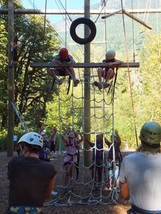
With some trepidation I said okay and was relieved to see that, although he didn’t slow down any, he was indeed more studied about how he managed himself. It was a small life lesson learned.
Would I choose to have my son injured as part of his investigation of the world around him? No. Did it turn out to be a productive experience? Yes. So, here is the question in our “risk averse” parenting world – how much risk (if any?) is a good thing?
If my children were trying to characterize me as a parent (or my students as a Principal) they would probably describe my approach to allowing them to take risks as somewhat akin to the inflatable cocoons that NASA has created to ensure a soft-landing for its Mars-bound spacecraft. When trees are being climbed or rock faces scaled, my heart becomes lodged permanently in my throat and I watch, absolutely certain, that the worst is bound to happen. As a result, protecting my children from risk is something that certainly works for me emotionally. But, to what extent does it work for them?
There is an on-going debate in Europe and North America that perhaps we are doing our children a disservice by making every effort to eliminate all risk from their day to day lives. A number of years ago, the Toronto Board of Education, based on a misreading of a consultancy report, dismantled more than half of its school playgrounds over the summer because it was felt that they were too dangerous. The slides were too high, the climbers too risky, and the swings presented an invitation for children to be launched into low orbit. Hundreds of thousands of dollars of equipment was destroyed and the children were left with safe, albeit barren, schoolyards. There was even the case last year of an elementary Principal banning soccer from the playground for the fear that someone might accidentally get hit by a ball!
So, where is the line? How much risk is acceptable? There is a growing school of thought that children should be presented with some measured opportunities to take risks. Now, let’s be clear, I am not talking about creating hazardous or dangerous situations, but rather letting students push their limits a little bit, taking the risk of moving to the next level.
Every day, as adults, we engage in automatic risk assessments. “Can I make it across the crosswalk before the light changes?” “Can I proceed in my car at this stop sign?” “Is this black diamond run a little too treacherous for me to try?”
We base these decisions on past (and sometimes painful) experiences. Our assessments of personal risk are honed by decades of taking chances. In fact, how many times have we all prevented our children (often rightly!) from doing something risky that we regularly did as kids ourselves? At what point then does some measure of risk become “acceptable” or even “desirable”?
The term "acceptable risk" is defined as “the likelihood of an event whose probability of occurrence is small, whose consequences are so slight, or whose benefits (perceived or real) are so great, that individuals or groups in society are willing to take or be subjected to the risk that the event might occur”. The idea of acceptable risk is an acknowledgement of the fact that absolute safety is generally an unachievable goal. But are there potential benefits as well?
For our children, the exposure to acceptable risk might be a combination of the building of self-esteem and independence that comes form doing something that they thought was beyond their capabilities, and the growth of personal judgment that will increasingly allow them to make reasoned risk assessments for themselves. They can’t live their lives with us perched on their shoulders. The sooner that we can help them to develop the skills of rational analysis of risk, a knowledge of their own capabilities and limitations, and the ability to make good decisions based on both, the better we prepare them for the next stage in their lives.
It isn’t easy to let go, even a little, as parents. But sometimes we just have to take the risk!


 RSS Feed
RSS Feed
